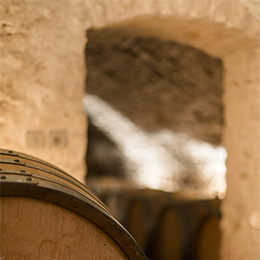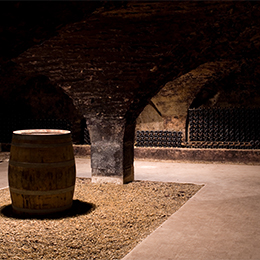When tasting a wine, it is customary to mention its vintage in addition to the plot of land where the grapes were grown. The mention of a wine’s year of birth contributes to its quality; there are good and bad years, all of them well known. But these four digits also come with plenty of personal associations – A memory of bad frost or a heatwave, the celebration of a birth or a success story, or a commemoration of someone lost. These memories come bubbling up to the surface in association, but this has not always been the case.
In the Middle Ages, where we often go on our hunt for traditions relating to the history of wine, no mention of vintage can be found in the archives. Wine was always the wine of that year. “Old” wines, those more than one year old, were of lesser quality. When a particular year was mentioned, as it was in 1398, from when a reference to “The wine from the harvest of 1396” can be found, it signified that the wine was inferior, and as such, less expensive. In around 1500 in Bordeaux, an “old wine” was sold for one eighth of the price of a new wine. And as such, there was no sense in looking for wines for keeping, or those aged for long periods in barrels in medieval cellars. This was not their time.

The same may have applied in Roman times for everyday wines. However, André Tchernia, an historian of Italian wines, also notes that there is, “No quality wine that is not aged”. It seems that during this period, great age was a guarantee of quality: Only the very best wines – those from Etruria (modern-day Tuscany) or Campania (in the region around Vesuvius) could be aged through a process of “maderization”, unlike common wines for everyday drinking. The poet Martial described wines in amphoras that were highly appreciated when drunk at 100 years old, and Pliny the Elder talked about drinking 200-year-old wines. During the feast of Trimalcion, Petronius had his characters bring “100-year-old Falerno wine [a celebrated wine from Campania], harvested under the consulship of Opimius”. It was customary to have the date painted on the amphora. This didn't directly state the year, rather the names of the consuls in office that year, for example: “Wine of Vesuvius, Vespasian consul.” Indeed, in Pompeii and Herculaneum, different amphoras were discovered, fossilized in the ashes from the eruption of Vesuvius in 79AD, marked with dates ranging from 43 to 71 AD, which would have held wines aged from between eight and 39 years. Elsewhere, a painted inscription reads: “Wine put in amphoras on 20 May of the year 13 BC from the harvest of 18 BC”. This wine had therefore been aged in vats for five years – a useful piece of information lacking on today’s labels!
It is only much later that we find this relationship between wines of distinction and any notion of the vintage, between the capacity to age well and offering superior quality. But we must go beyond the Middle Ages and look at the late 17th and early 18th century, when “great wines” or rather, the quality indicators for wines of distinction were invented: Wines from the Bourgogne Climats, wines of specific Bordeaux crus or estates, and branded wines from Champagne houses. This was when vintages became commonplace. In Champagne, however, the distinction between regular wines and vintages is still maintained today. Furthermore, during this pivotal period for the wines of Bourgogne, it was time to stand out from the crowd, and differentiate in terms of terroir, Climat, and the time and year – differences that would together make a lasting imprint.
The custom of inscribing the construction date of a house above the main door had the same effect in the 17th century: The stone was then entrusted with the role of carrying the date the house came into being for all eternity. It was also during this period that birthdays began being celebrated every year. As for us people, the vintage then came to mark a wine’s year of birth and foundation. These wines then became wines for keeping, which would be aged in the cellar for several years to see them evolve. As such, long-term knowledge was being developed about the ageing process. This was the remit of the cellar master, who understood the different woods and barrels, the rackings-off, and the nurturing to be provided over the many years the wine lives in the barrel.

The inventory of the cellars of King Louis XVI in 1784 listed bottles of the best Bourgogne Climats from the years 1774, 1778, and 1779; a practice that wasn’t even seen in the famous ducal cellars of the Middle Ages.
As years were differentiated, a hierarchy naturally emerged. It would become customary to classify vintages, to make recommendations and tell stories, creating a new distinction of value in terms of time and years. In wine writing, a distinction is made between “great years” and “lesser years” for vintage wines. In terms of the 19th century, Lachiver records good years for wines from across France, including 1798, 1802, 1811, 1815, 1819, 1822 (one of the hottest years of the 19th century, which was harvested on 30 August), 1825, 1834, 1846 (a hot and early year that produced a “pure blood” wine), up until 1893, “the year of the century”. The “Comet wine” of 1811 was produced in a wonderful year announced by a star that shone every night during the summer months. Many other “comet wines” would follow.
There were also terrible years, such as 1809, 1817, 1826, 1845, and especially 1816: “the year of no summer” and one without harvest either, since it snowed in July. This sudden cooling of the climate was due to the eruption of the Tambora volcano in Indonesia in 1815. Some of these bad vintages also bear the memory of the first attacks of diseases and insects, including 1818, 1819, and 1825 (moths) and 1847 (powdery mildew).
During the 20th century, it became increasingly common to include the vintage on wine bottles, in its prominent spot on the collar and on the label itself. It seems obvious now for AOC wines, but the inclusion of the vintage is not mandatory and winegrowers are permitted to blend one vintage with another to a maximum of 15%. This can help save low-yielding years, when winegrowers fall foul of hail and frost.
As vintages become distinct from one another, life in the vines and the lives of the winemakers become more and more intertwined to the point when each bottle is like a fleeting snippet of memory. For example, during a tasting of a bottle from 1965 (the year of my birth and a minor year for wine), emotions ran high when we suddenly realized that this was the last of the vintage, that we were the last ones to be able to taste this vintage and this year, and that there would be nothing more left of this wine but a memory inscribed in words, in the moment, and in the emotion. “Fugit irreparabile tempus ," as Virgil said.
Jean-Pierre Garcia, Professor at the University of Bourgogne
Published with the kind permission of Bourgogne Aujourd’hui magazine. This text comes from an article in a special edition of Bourgogne Aujourd’hui focusing on vintages (number 160). Click the link for all previous editions on https://www.bourgogneaujourdhui.com/